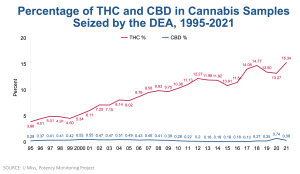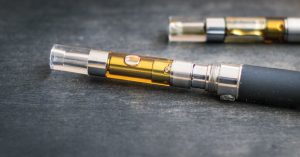5 Marijuana Overconsumption and Tolerance
Delaney Morley
Marijuana and Cannabis Use Disorder (CUD)
Marijuana, or its scientific name, Cannabis sativa contains a psychoactive substance called tetrahydrocannabinol (THC), which is the most common cannabinoid (NIH, 2019). THC is responsible for the “high” that users experience. According to the U.S. Department of Health and Human Services (2019), marijuana is among the most used drugs in the United States, especially among adolescents and young adults.
Some individuals who use cannabis frequently or at increasingly high amounts can develop cannabis use disorder (CUD), which is the inability to stop using cannabis, even when cannabis is causing the person any type of harm socially or physically (Yale Medicine, 2022). Globally, 22.1 million people meet the diagnostic criteria (Connor et al., 2021). Three out of ten people who use marijuana will develop or already have CUD (CDC, 2020).
Modern Marijuana

Marijuana today is vastly different from the marijuana commonly used in the 1970s. In the 1970s, the average THC level in marijuana was around one percent. In the 2020s, the average level is approximately 15%, with some plants containing as much as 30% (RevClinics Team, 2022). This increase in potency results in more intense effects on the brain and body. Since a euphoric high is what the consumer is chasing (Stuyt, 2018), the industry has continuously searched for ways to increase the THC levels in marijuana plants.
The method of consumption affects how the body processes it. Common consumption methods include dabbing, edibles, and smoking marijuana extract (wax) (Marijuana FactCheck, n.d ). Before its increased popularity, marijuana was typically baked into desserts as an alternative to smoking (American Addiction Centers, 2022). This process resulted in low levels of THC. Today’s edibles contain higher THC levels and are typically sold as candies or gummies. These higher THC levels can cause more intense and harmful effects (U.S. Department of Health and Human Services, 2019). Many users may be unaware of the consequences due to a lack of education (NIH, 2020).
Methods Common in Overconsumption
A user may intentionally or unintentionally take too much THC (either at once or daily use), leading to overconsumption. In the case of marijuana, this can lead to extreme confusion, anxiety, delusions, increased blood pressure, and sometimes severe vomiting (CDC, June 2021). Eating edibles or using dabs has the highest overconsumption risk. The CDC (2020a) states that some methods of marijuana consumption may give very high levels of THC to the user.
Edibles can be easily misused due to a lack of oversight when THC is added. The effects of edibles take up to 30 minutes since the drug has to pass through the digestive system. The slow uptake can cause people to take even more, thinking the original dose did not work (NIH, 2020). There is an increased risk of marijuana toxicity, or overdose when taking an edible compared to other methods such as inhalation (American Addiction Center, 2022).

Dabbing (as seen above) is another method that can easily lead to marijuana overconsumption. The user receives the drug effects quicker than if they were to smoke a joint. Inexperienced users may not be educated about the immediate drug impact, which increases poisoning potential. If marijuana poisoning or toxicity has occurred, contact local poison control or 911 if it is an emergency (CDC, 2020b)
Marijuana Tolerance
The short-term effects of marijuana on the brain impacts cognition, such as thinking, time perception, attention, and memory (CDCa, 2020). The biggest concern for long-term use is the impact on brain development. According to the Centers for Disease Control and Prevention (September 2021), 37% of United States high schoolers reported using marijuana at least once. This rate is concerning because the human brain does not stop developing until age 25. As this use continues, the user can experience short- and long-term consequences (CDC, September 2021).
Like many substances, a person can build a tolerance to THC. High potency or high consumption can lead to tolerance among people with repeated drug use. Higher THC doses can lead to tolerance more rapidly. Tolerance and the associated changes in the brain cannabinoid receptors, specifically CB1, are associated with dependency (Gonzalez et al., 2005). Ramaekers et al. (2016) suggest that long-term cannabis use can reduce physiological responses (the body’s initial reaction) to the drug, meaning a higher tolerance has been reached. Frequent and chronic cannabis use can lead to changes in brain signaling, leading to the development of CUD (Gonzalez et al., 2005).
Conclusion
CUD can lead to a variety of lifestyle issues, such as relationship problems, financial struggles, low energy, and confidence (Budney et al., 2007). These issues act as disruptions and can lead to deeper struggles in a person’s life. Long-term biological consequences of CUD are an increased risk of schizophrenia in adolescents, long-term damage to the lungs, and issues with memory and attention (Yale Medicine, 2022). Many people with this disorder seek treatment in order to quit. A common treatment is behavioral therapy, including motivational interviewing, which can help people overcome the disorder (Yale Medicine, 2022). While people trying to quit will experience withdrawal symptoms such as irritability and restlessness, there will also be positive changes in their life. These positive effects are increased energy and focus, along with a more balanced attitude and sleep schedule (Midwest Recovery Centers, 2022). Lifestyle benefits can improve financial stability, academic performance, and relationships.
Review Questions
1. Which of the following best explains cannabis use disorder?
a. The use of cannabis for enjoyment, without any dependency
b. A single occurrence of overuse of marijuana
c. The inability to stop using cannabis, even when it is causing any type of harm
d. A rare disorder that only affects adults
2. How have THC levels changed over time?
a. THC levels have increased
b. THC levels have decreased
c. THC levels have not changed
3. Which of the following describes tolerance?
a. Ingesting a high amount of the drug
b. It takes more of the given drug to feel the effect
c. A need to take the drug frequently
d. An effect that can only occur when dabbing marijuana
References
American Addiction Centers Editorial Staff. (2022, November 30). Edibles and THC overdose: Signs, effects, and treatment. Recovery.org. https://recovery.org/marijuana/edibles-thc-overdose/
Budney, A. J., Roffman, R., Stephens, R. S., & Walker, D. (2007). Marijuana dependence and its treatment. Addiction Science & Clinical Practice, 4(1). https://doi.org/10.1151/ASCP07414
Centers for Disease Control and Prevention. (2020a, October 19). Brain health. https://www.cdc.gov/marijuana/health-effects/brain-health.html
Centers for Disease Control and Prevention. (2021, September 8). Teens. https://www.cdc.gov/marijuana/health-effects/teens.html
Centers for Disease Control and Prevention. (2021, June 11). Marijuana FAQs. https://www.cdc.gov/marijuana/faqs.htm
Centers for Disease Control and Prevention. (2020b, October 19). Poisoning. https://www.cdc.gov/marijuana/health-effects/poisoning.html
Centers for Disease Control and Prevention. (2020c, October 19). Addiction. https://www.cdc.gov/marijuana/health-effec/addiction.html#:~:text=Some%20people%20who%20use%20marijuana,social%20problems%20in%20their%20lives
Connor, J. P., Stjepanović, D., Le Foll, B., Hoch, E., Budney, A. J., & Hall, W. D. (2021, February 25). Cannabis use and cannabis use disorder. Nature News. https://www.nature.com/articles/s41572-021-00247-4
González, S., Cebeira, M., & Fernández-Ruiz, J. (2005). Cannabinoid tolerance and dependence: A review of studies in laboratory animals. Pharmacology Biochemistry and Behavior, 81(2), 300-318. 10.1016/j.pbb.2005.01.028
Marijuana FactCheck. (2018, October 1). Potency. https://www.mjfactcheck.org/potency#:~:text=How%20strong%20is%20marijuana%3F,and%20up%20to%2090%25%20THC
Midwest Recovery Centers. (2022, August 24). Benefits of quitting marijuana and a timeline of effects. https://www.midwestrecoverycenters.com/benefits-of-quitting-marijuana/
Ramaekers, J. G., van Wel, J. H., Spronk, D. B., Toennes, S. W., Kuypers, K. P. C., Theunissen, E. L., & Verkes, R. J. (2016, May 26). Cannabis and tolerance: Acute drug impairment as a function of cannabis use history. Nature News. https://www.nature.com/articles/srep26843
Revolutionary Clinics. (2022, April 28). How THC potency has changed over time.https://www.revolutionaryclinics.org/thc-potency-over-time/
Stuyt, E. (2018). The problem with the current high potency THC marijuana from the perspective of an addiction psychiatrist. Missouri Medicine, 115(6), 482–486.
U.S. Department of Health and Human Services. (2019, November). Cannabis (marijuana) and cannabinoids: What you need to know. National Center for Complementary and Integrative Health. https://www.nccih.nih.gov/health/cannabis-marijuana-and-cannabinoids-what-you-need-to-know#:~:text=The%20word%20“marijuana”%20refers%20to,plants%20contain%20very%20little%20THC
U.S. Department of Health and Human Services. (2020, July). What are marijuana’s effects? National Institutes of Health. https://nida.nih.gov/publications/research-reports/marijuana/what-are-marijuana-effects
Yale Medicine. (2022, June 30). Cannabis/marijuana use disorder. Yale Medicine. https://www.yalemedicine.org/conditions/marijuana-use-disorder
the dried leaves, flowers, stems, and seeds of the Cannabis sativa plant
affecting the mind or behavior
the chemical within marijuana responsible for producing a high
any of various naturally-occurring, biologically active, chemical constituents of hemp or cannabis including some that have psychoactive properties
a set of signs, symptoms, and tests used when identifying a person's condition
an extreme, unrealistic feeling of well-being
inhaling the vapors of a concentrated extract of cannabis when it is heated
any food item containing THC
the excessive consumption or use of something
an inability to distinguish between what is real and what only seems to be real
occurs when someone consumes too much cannabis at one time and experiences paranoia, psychosis, decreased judgment, and decreased coordination
the conscious mental process involved in gaining knowledge and understanding the world
a person's diminished response to a drug over repeated exposure, requiring higher doses to feel the effect
a serious mental condition of a type involving a breakdown in the relation between thought, emotion, and behavior, leading to faulty perception, inappropriate actions and feelings, withdrawal from reality and personal relationships into fantasy and delusion, and a sense of mental fragmentation.
psychotherapy concerned with the treatment (by desensitization or aversion therapy) of a behavior by applying principles of learning to substitute a desirable response and behavior pattern for an undesirable one

